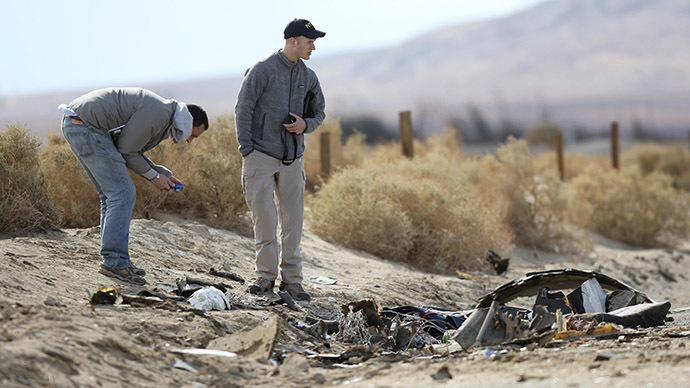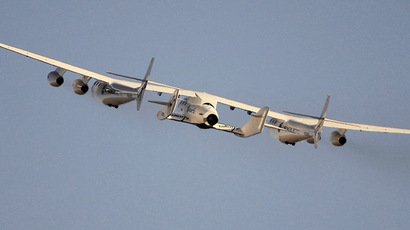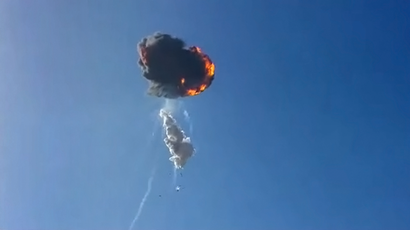Faulty descent system may be behind Virgin Galactic SpaceShipTwo’s fatal crash

US investigators probing the crash of SpaceShipTwo on Friday, which killed one pilot and left another seriously injured, say it may have been caused by the craft’s unique ‘feathering device’, designed to slow it on re-entry to the atmosphere.
Christopher Hart, the head of Air Safety at the US National Transportation Safety Board (NTSB) said the function to help the space plane descend into the earth’s atmosphere had been deployed early. A lever used to operate the feathered position came into play about 9 seconds after ignition, earlier than it should have.
READ MORE: Virgin Galactic crash: Branson says won’t push space tourism ‘blindly’
The effect of the unique feathering system is to make the spaceship behave like a shuttlecock in Badminton. The drag over the vehicle on descent makes it adopt a belly-down position. This gets round the need for a complicated system of small thrusters, which are used on other spacecraft for re-entry.
However, Hart emphasized the cause of the crash had not been determined and that all investigators had found was that the feathering system had been deployed before the craft had reached the appropriate speed.
The device is supposed to be activated at Mach 1.4 (1,715 km/h), but had, in fact, been triggered at Mach 1.
Its deployment takes two stages: firstly one pilot enables the device by unlocking it, and Hart said that the co-pilot had done this. It then must be deployed, but Hart said this command had not been given.
He also cautioned that the investigation was months from finding out what happened to the doomed spacecraft, and that both pilot error and mechanical failure were being considered.
But Hart did say that the debris field on the ground suggested that SpaceShipTwo(SS2) broke up in flight.

READ MORE: Virgin Galactic's SpaceShipTwo crashes in Mojave desert killing pilot
Early media reports suggested that the rocket engine and the fuel they used may have been to blame, but Hart also said that the engine and the fuel tanks were found intact.
Virgin Group boss, Richard Branson, has blasted a “handful of British newspapers” for publishing “wild accusations” on the cause of the crash, including that new nitrous oxide fuel may have been to blame.
“Rumors and innuendo from self-proclaimed experts can be put back in their box,” Branson told the BBC, insisting that safety is the Virgin Group’s prime concern.
But, although it may not have been the cause of Friday’s crash, the nitrous oxide fuel used by SpaceShipTwo has been criticized by a number of engineers and scientists.
Geoff Daly, a rocket scientist, who has been highly critical of the Virgin Galactic space tourism project, said that using the fuel in large amounts is unchartered territory and that there were also fundamental design flaws in the rocket system.
“It’s [nitrous oxide] still very poorly understood in large quantities…The temperature of the fuel is critical,” he said, as quoted by The Guardian, adding: “The delivery system is solid, the motor is bolted to the fuel tanks. There is no flexibility in the tank and the motor - any vibration can result in the fracture and failure of the engine system.”

In 2007, three workers were killed in an explosion at the Virgin Galactic spaceport, where nitrous oxide was a factor, and Daly warned the Federal Aviation Authority (FAA) several times last year that if test flights were given the go-ahead another disaster was likely.
Friday’s flight was the fourth for SS2. Virgin Galactic was hoping to begin the first commercial flights as early as next spring. Now the project’s future depends on the conclusion from the NTSB.
READ MORE: Risky business: Top 5 failures of US commercial space program (PHOTO, VIDEO)
SS2’s predecessor, SpaceshipOne, went to the edge of space and back twice in the space of two weeks ten years ago. However, it was smaller and could only accommodate two astronauts, not enough to make it commercially viable.
SS2 is designed to carry six paying passengers and two pilots up to the edge of the earth’s atmosphere so they can experience weightlessness and see the earth’s hazy blue atmosphere. The starting price is $250,000.
The project has been beset by delays since it was launched in 2004 and is now also in financial difficulties after $400 million in funding from Abu Dhabi dried up. Virgin Group themselves have had to pay day-to-day expenses, the Financial Times reported.















